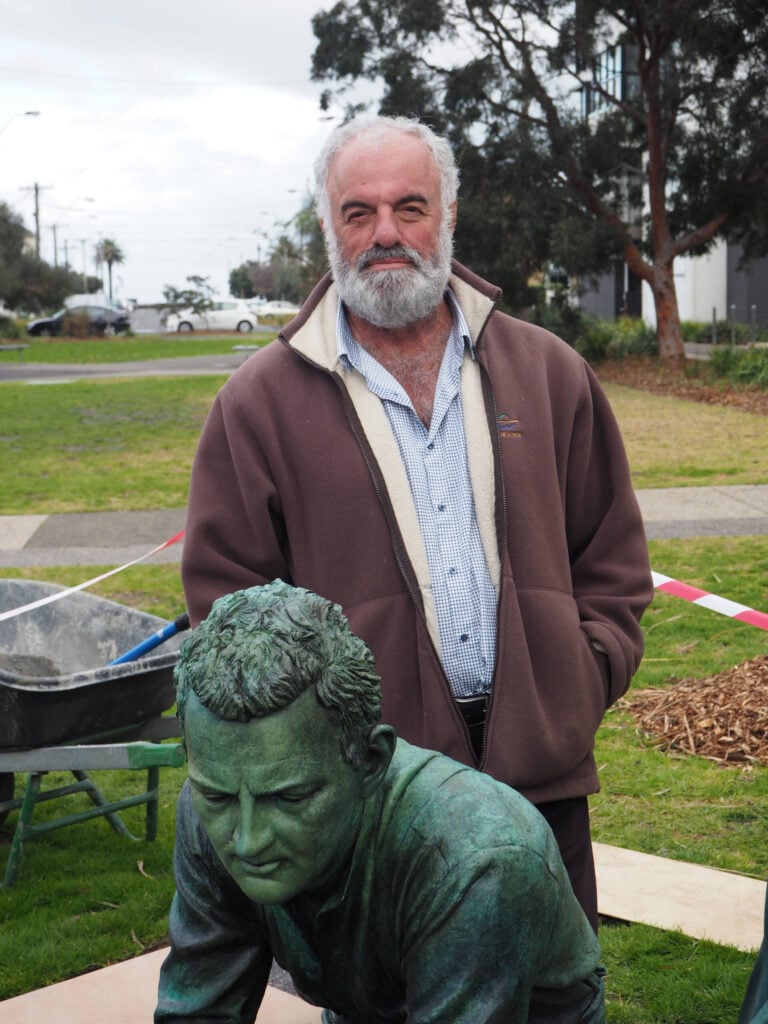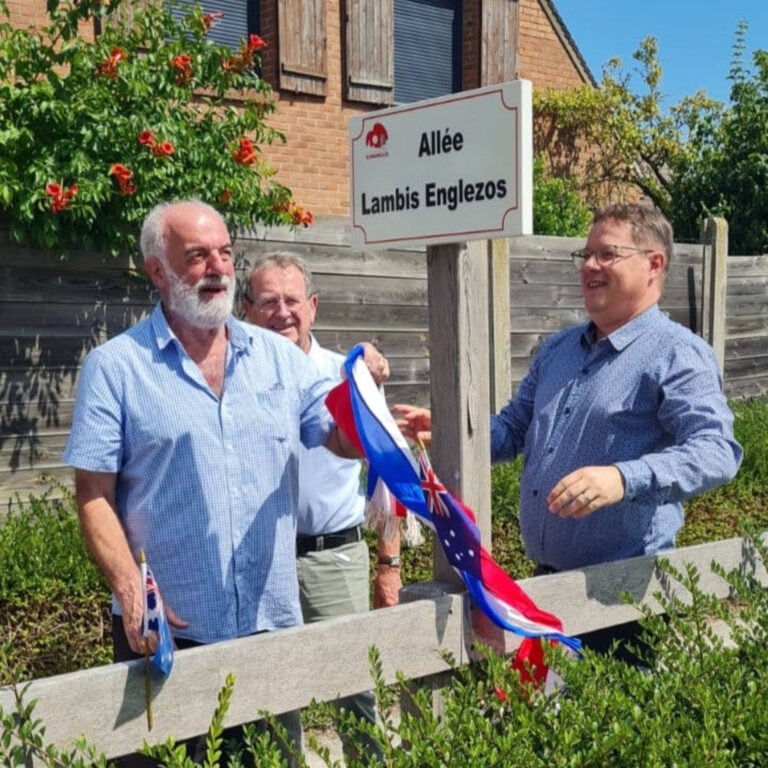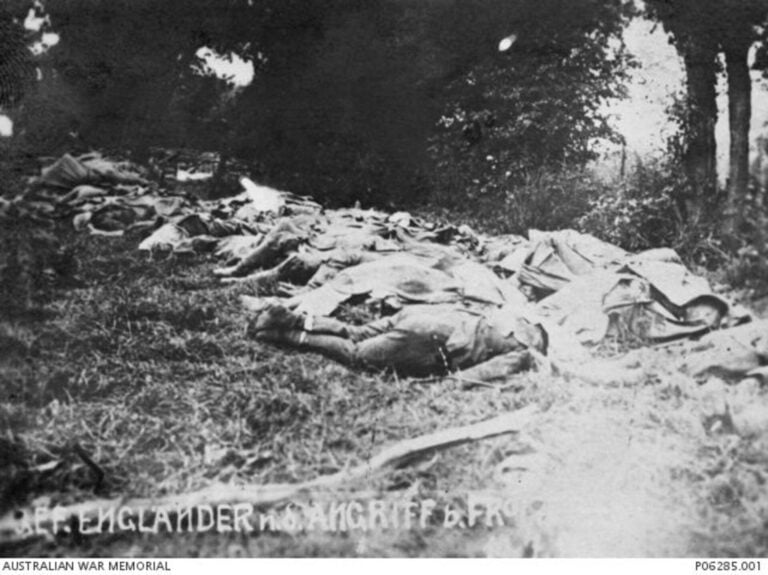One of Melbourne’s Greek community treasures – Lambis Englezos AM – has been awarded a special honour in the northern French village that has played a key part in his important commemorative work. Recently, the local municipality – the Commune de Fromelles – honoured him by naming a path in the village as the new Allee Lambis Englezos. It was unveiled in July this year in the presence of Fromelles Mayor Jean-Gabriel Masson and former Mayor Hubert Huchette.
Many readers and members of the community will know of Lambis and his work. He is a regular attendee at many commemorative events, including OXI Day at the Australian Hellenic Memorial and the Battle of Crete commemorations at Melbourne’s Shrine of Remembrance. He is also one of the patrons of our own Lemnos Gallipoli Commemorative Committee and a regular attendee at our annual service held every August. It was at Lambis’ recommendation that our Committee successfully approached sculptor Peter Corlett OAM to design and create our Lemnos Gallipoli Memorial.
It has been over 20 years since this former art teacher began his journey of discovery into the missing of the Battle of Fromelles. Taking place on 19 July 1916, the battle was the first major engagement of Australian troops on the Western Front. It saw soldiers of the Australian 5th Division and British 61st (South Midlands) Division engage in a terrible and costly attack conducted in broad daylight on a heavily defended German line. Over 5,500 Australians became casualties, almost 2,000 were killed or died of wounds, and some 400 were taken prisoner. The Australian War Memorial states that the losses are believed to be the greatest suffered by a single Australian division in 24 hours during the entire First World War. Many regard Fromelles as the most tragic event in Australian military history.
“For more than a decade now, Lambis Englezos has been building his wall, driven by his passionate commitment to the ‘missing’ of Fromelles” — Nigel Steel, WWI historian
In November 1918, Australia’s official war correspondent Charles Bean visited the battlefield and found the grisly site “simply full of our dead”, with skulls and bones lying everywhere. These remains were later gathered to construct the VC Corner Cemetery, which lists the names of 1,299 Australians who died in the battle nearby with no known grave, and two grass plots containing the unidentified remains of 410 of the dead.
In 1998, a new Australian Memorial Park was dedicated close to the cemetery and on part of the former German frontline briefly captured by the Australians in the battle. It contains the remains of German defences as well as a bronze statue, named “Cobbers”, created by Peter Corlett OAM, depicting Sergeant Simon Fraser of the 57th Battalion.
Yet 1,335 Australian soldiers remained missing from the Fromelles battle. This is where the research and advocacy of Lambis comes in. His journey began with a visit to the Fromelles battlefield in 2002. On his return to Australia, he sought answers to the question of these missing men. His research revealed that those killed behind German lines were buried by the Germans, with their personal effects returned to Australia through the Red Cross. Soon he was studying the Red Cross Wounded and Missing files and reading Robin Corfield’s excellent history Don’t forget me, cobber. This led him to a place called Pheasant Wood as a possible location for the graves. He found that 175 Australians had been buried behind German lines. Aerial photography from around the time of the battle showed intriguing anomalies, and German military documents revealed an order to prepare graves for 400 bodies.

Along with other members of the Friends of the 15th Brigade, Lambis presented their case for a formal investigation of the Pheasant Wood site to officials in Canberra in 2005. This led to archaeological surveys beginning at the site in 2007, conducted by battlefield archaeologist Professor Tony Pollard and his specialist team from Glasgow University. In 2009, Oxford Archaeology carried out the excavation and analysis of the skeletal remains of 250 Australian and British soldiers at Fromelles. Through a combination of forensic archaeology, archival research, and DNA testing, the remains of 90 Australian soldiers were successfully identified by name – a total which has grown to 97, with more still to be identified.
As Lambis has written, these excavations were carried out “with real empathy” for the soldiers and their remains. He goes on to acknowledge the generous donation of the land itself by Madame Demassiet, who declared that it “belongs to the soldiers.”
In early 2010, most of these remains were reinterred with full military honours in the new Fromelles (Pheasant Wood) Military Cemetery, constructed by the Commonwealth War Graves Commission, alongside a new Museum of the Battle of Fromelles. On the 94th anniversary of the battle in July 2010, the last of the 203 Australian soldiers recovered from the excavation were buried in a solemn ceremony, with a private service for the descendants of identified soldiers held later that same day.
No better tribute has been paid to Lambis’ work at Fromelles than that by renowned WWI historian Nigel Steel, writing in the Australian War Memorial’s Wartime magazine in 2021. Likening each new historical effort to placing a brick in a wall that gives us a better understanding of the past, he wrote:
“For more than a decade now Lambis Englezos has been building his wall, driven by his passionate commitment to the ‘missing’ of Fromelles. Others, professionals and amateurs alike, have played their part, but many of these have been inspired and informed by Englezos’s research and unwavering conviction. The result – Englezos’s wall – is a remarkable achievement, leading to the discovery of the ‘missing’ of Fromelles …”

In undertaking his work, Lambis has always generously acknowledged the other volunteers and professionals who joined him on his journey of discovery – especially the descendants of those who served at Fromelles, many of them members of the Friends of the 15th Brigade, of which Lambis is an active member. Indeed, Lambis’ interest in the story has always been very personal, enriched by having actually met some of the surviving men of the Battle of Fromelles – “19th July men”, as he says.
This recent recognition of Lambis’ work in Fromelles adds to a long list of honours bestowed on him for his selfless and dedicated volunteer work over many years. In June 2009, Lambis received one of the highest Australian civic honours, being awarded a Member of the Order of Australia “for service to the community through research and advocacy roles relating to Australian soldiers of the Great War buried in Fromelles, France”. A fitting Australian recognition.
Since 2013, an annual educational scholarship in his name has been established by his old school – Melbourne High School – with the scholarship awarded to an MHS Old Boy currently undertaking undergraduate studies in any area relevant to current or past Australian-French relations. It is no surprise that well-known
Melbourne Cypriot-born artist George Petrou OAM has also captured Lambis in a stunning portrait.
In response to the naming of Allee Lambis Englezos, many tributes on social media have poured in for Lambis and his work, praising the appropriateness of this unique honour in the village where he has made such a moving contribution to this powerful page in Australian-French history. Many of these tributes are from Lambis’ friends among the descendants of those who served and were killed at Fromelles all those years ago.

One of Lambis’ close friends, Lee Tarlamis OAM MP, welcomed the French honour. “Lambis’ commitment to finding the missing of Fromelles is testimony to his dedicated effort in pursuing this important part of Australia’s military history. But as we all know, he was moved by the personal tragedy at the centre of this story. This work is obviously of great benefit to the descendants of the missing, but everyone’s knowledge of Australia has been enriched by Lambis’ work. A well-deserved honour,” he said.
Lambis regularly returns to Fromelles to visit the cemetery and reconnect with the many locals who have been part of his journey. Veterans’ descendants often accompany Lambis on these moving visits. Readers can join Lambis on his next guided tour of the Fromelles site as part of the Matt McLachlan Battlefield Tours. The 11-day tour leaves Paris on 15 July.
“This work is obviously of great benefit to the descendants of the missing, but everyone’s knowledge of Australia has been enriched by Lambis’ work” — Lee Tarlamis OAM MP
On a personal level, I find this one of the most interesting and fruitful aspects of migration. Arriving in Australia – from wherever your origins – introduces one to a whole new world of experience, with a unique history and culture that can intoxicate and challenge. Often, we hear of the difficulties of arrival and settlement, but there are also opportunities that would not have been experienced in the old lands. Lambis’ enthusiasm and dedication to the Australian Fromelles story represents one of the fruits of that interaction. He embraced this story and brought new light to it. I join with many in congratulating Lambis, his work, and this new and well-deserved honour.
*Jim Claven is a trained historian, freelance writer and published author, as well as foundation Secretary of the Lemnos Gallipoli Commemorative Committee. The grandson of a WW1 Western Front veteran, he is the author of Lemnos & Gallipoli Revealed. Readings seeking more information are referred to the AWM & UNSW AIF Project websites, Peter Barton’s ‘The Lost Legion’s of Fromelles’, Peter Cornfield’s book and especially Lambis’ own account of his Fromelles work on the AWM website in an article entitled “My quest to find the missing”. More information on Lambis’ part of Matt McLachlan Battlefield Tours or the Melbourne High School Lambis Englezos Scholarship can be found on the relevant websites. Jim can be contacted via email – jimclaven@yahoo.com.au